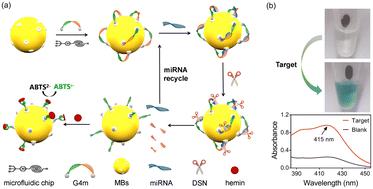Our official English website, www.x-mol.net, welcomes your feedback! (Note: you will need to create a separate account there.)
Label-free microRNA detection using a locked-to-unlocked transforming system assembled by microfluidics
Lab on a Chip ( IF 6.1 ) Pub Date : 2022-11-18 , DOI: 10.1039/d2lc00911k Xuting Liu 1 , Yi Zhen 1 , Nengsheng Ye 1 , Lu Zhang 1
Lab on a Chip ( IF 6.1 ) Pub Date : 2022-11-18 , DOI: 10.1039/d2lc00911k Xuting Liu 1 , Yi Zhen 1 , Nengsheng Ye 1 , Lu Zhang 1
Affiliation

|
MicroRNA (miRNA) is a potential biomarker for the early screening and diagnosis of cancers and is widely present in human blood, urine and saliva. Here, we report a microfluidics-assembled tool for miRNA detection based on the regulation of DNA locked and unlocked states and explore its application in complex samples. Microfluidic techniques are used to continuously assemble the locked-to-unlocked transforming system using a rapid one-step method. It only takes 2 min to produce enough locked-to-unlocked systems for a miRNA detection experiment. DNA molecules with a recognition sequence and a G-rich reporter sequence (G4m) are locked by attaching both ends to the surface of magnetic beads (MBs) in microchannels. The presence of the target miRNA can initiate the specific cleavage of one end of G4m by duplex-specific nuclease, resulting in the transition of G4m from a locked state to an unlocked state. This transition enables G4m to freely fold into a G-quadruplex, which can participate in the catalysis of ABTS oxidation and result in a turquoise color. During the whole process, the target miRNA remains intact and continuously initiate specific cleavage, facilitating signal amplification. Magnetic separation steps are employed to assist in miRNA enrichment and interference reduction. As a proof of concept, we quantified miRNA-21 using the locked-to-unlocked system. The assay allows specific detection of miRNA-21 in the range of 3.2–570 pM with a detection limit of 2.01 pM (S/N = 3). Furthermore, the locked-to-unlocked system is used to analyze miRNA-spiked urine, saliva and serum samples and shows robust performance in different matrices.
中文翻译:

使用由微流体组装的锁定到解锁转换系统进行无标记 microRNA 检测
MicroRNA (miRNA) 是一种潜在的癌症早期筛查和诊断生物标志物,广泛存在于人体血液、尿液和唾液中。在这里,我们报告了一种基于 DNA 锁定和解锁状态调节的用于 miRNA 检测的微流体组装工具,并探索了它在复杂样本中的应用。微流体技术用于使用快速一步法连续组装锁定到解锁的转换系统。只需 2 分钟即可为 miRNA 检测实验生成足够的锁定到解锁系统。具有识别序列和富含 G 的报告序列 (G4m) 的 DNA 分子通过将两端连接到微通道中的磁珠 (MB) 表面来锁定。目标 miRNA 的存在可以通过双链特异性核酸酶启动 G4m 一端的特异性切割,导致 G4m 从锁定状态转变为解锁状态。这种转变使 G4m 能够自由折叠成 G-四链体,参与 ABTS 氧化的催化并产生绿松石色。在整个过程中,目标miRNA保持完整并不断启动特异性切割,促进信号放大。采用磁性分离步骤来帮助 miRNA 富集和干扰减少。作为概念证明,我们使用锁定到解锁系统对 miRNA-21 进行了量化。该测定允许在 3.2–570 pM 范围内特异性检测 miRNA-21,检测限为 2.01 pM (S/N = 3)。此外,锁定到解锁系统用于分析掺有 miRNA 的尿液、唾液和血清样本,并在不同基质中表现出稳健的性能。
更新日期:2022-11-18
中文翻译:

使用由微流体组装的锁定到解锁转换系统进行无标记 microRNA 检测
MicroRNA (miRNA) 是一种潜在的癌症早期筛查和诊断生物标志物,广泛存在于人体血液、尿液和唾液中。在这里,我们报告了一种基于 DNA 锁定和解锁状态调节的用于 miRNA 检测的微流体组装工具,并探索了它在复杂样本中的应用。微流体技术用于使用快速一步法连续组装锁定到解锁的转换系统。只需 2 分钟即可为 miRNA 检测实验生成足够的锁定到解锁系统。具有识别序列和富含 G 的报告序列 (G4m) 的 DNA 分子通过将两端连接到微通道中的磁珠 (MB) 表面来锁定。目标 miRNA 的存在可以通过双链特异性核酸酶启动 G4m 一端的特异性切割,导致 G4m 从锁定状态转变为解锁状态。这种转变使 G4m 能够自由折叠成 G-四链体,参与 ABTS 氧化的催化并产生绿松石色。在整个过程中,目标miRNA保持完整并不断启动特异性切割,促进信号放大。采用磁性分离步骤来帮助 miRNA 富集和干扰减少。作为概念证明,我们使用锁定到解锁系统对 miRNA-21 进行了量化。该测定允许在 3.2–570 pM 范围内特异性检测 miRNA-21,检测限为 2.01 pM (S/N = 3)。此外,锁定到解锁系统用于分析掺有 miRNA 的尿液、唾液和血清样本,并在不同基质中表现出稳健的性能。


























 京公网安备 11010802027423号
京公网安备 11010802027423号